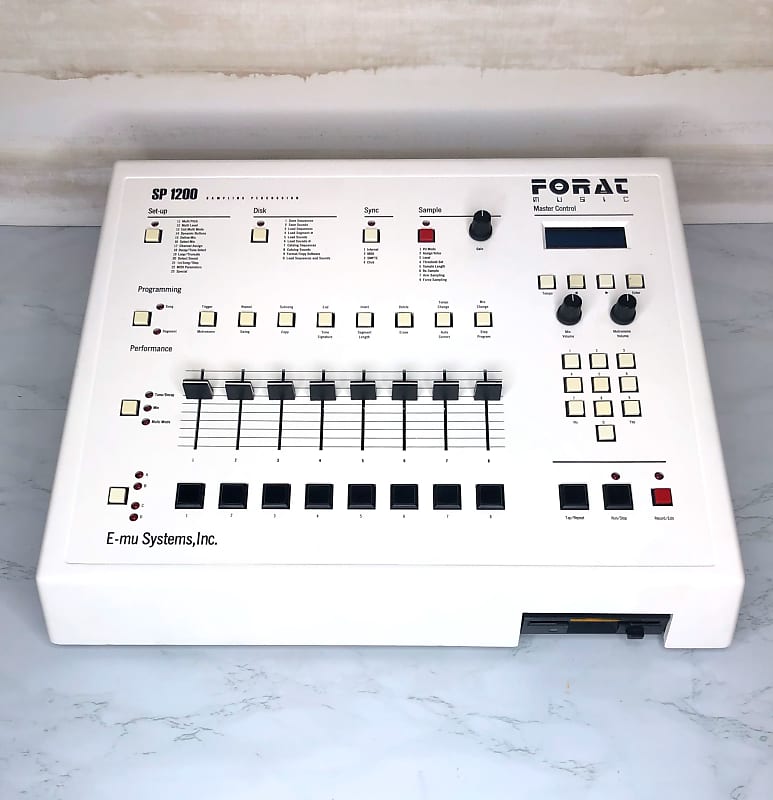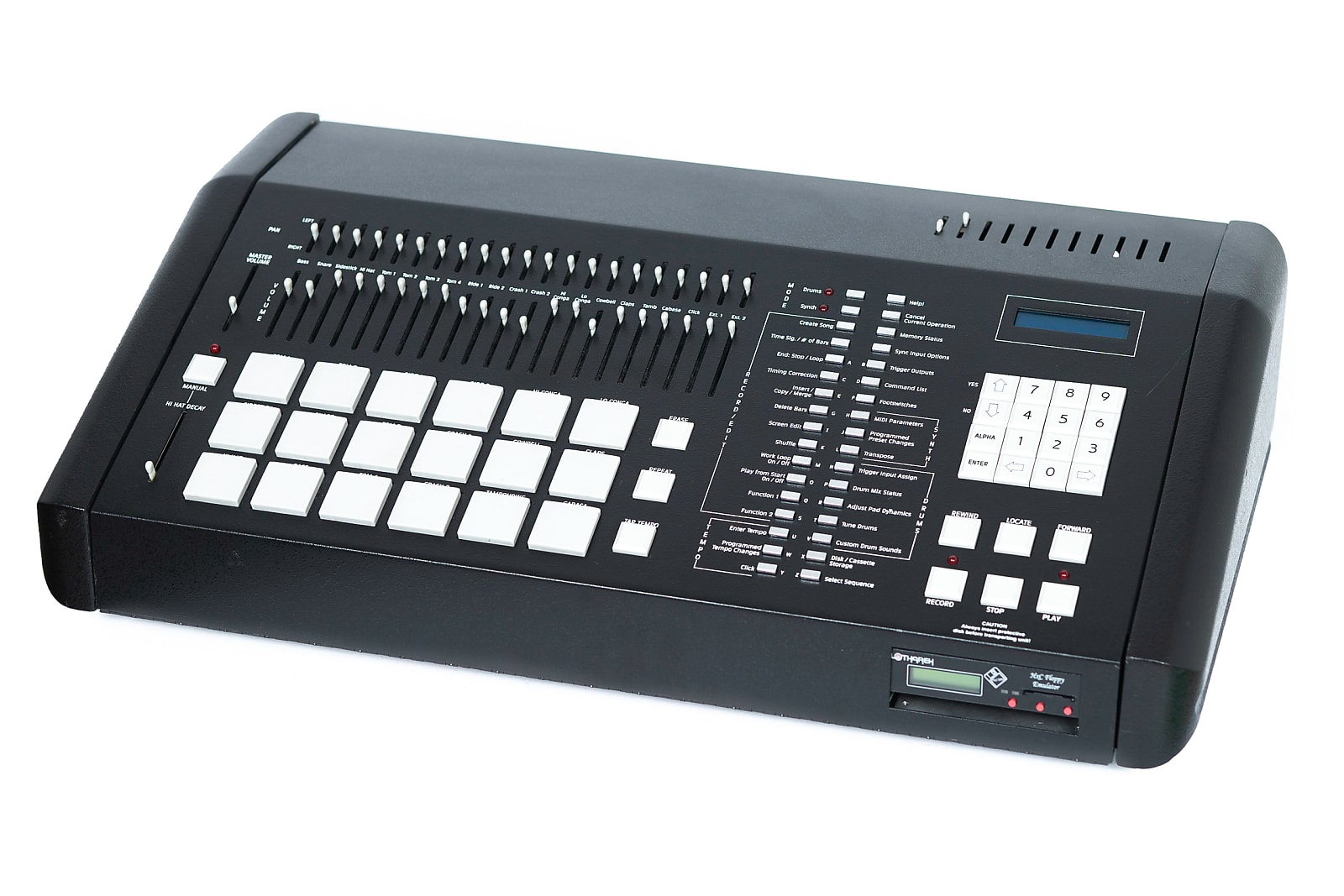It’s a long, low white building in the middle of a block on Ventura Boulevard. The entrance is tree-shaded, and if you miss the rooftop sign advertising Forat Electronics, you might easily pass it by. But this Studio City workshop was once the nerve center of drum machine technology.

If you owned a Linn 9000 back in the ‘80s and ‘90s, this is where you would have sent it to be serviced—or brought it yourself, if you lived in Los Angeles. And if you brought it in, you’d probably have run into some of the heaviest hitters in the music business—or, at least, their drum machines. They were all repaired by Bruce and Benny Forat, the brothers who cracked the software code of the Linn 9000, Roger Linn’s cutting-edge drum machine.
“Absolutely everybody was there,” recalls Oliver Leiber, the guitarist and songwriter who penned several No. 1 hits for Paula Abdul and helped produce her multi-platinum 1988 album, Forever Your Girl. “You could not have a Linn 9000 and not have the Forats,” Leiber tells me.
Jeff Lorber, the Grammy-winning keyboardist and producer, agrees. “The Forats are really the unknown heroes of drum machines. No one knew who these guys were—unless they were working on your stuff. Then everyone knew who they were.”
Bruce Forat himself echoes this sentiment. “The people who need to know me already know me,” he says. “And the people who don’t know me will find out about me from their friends.” Even today, that word-of-mouth reputation makes it likely you’ll find him wielding a soldering iron. Although he admits it’s far from his favorite activity, the demand for drum machine repairs remains strong, decades after standalone machines faded from the scene.
Now nearing age 60, Bruce Forat has racked up more than five decades of experience in electronics repair. He and his brother Benny were immersed in the field from an early age. “My dad was into electronics,” he recalls. “So both me and my brother, for toys, we used to get these kits. And we had to learn how to solder, like, back when I was seven.”
Electronics seemed to dovetail perfectly with Bruce Forat’s other childhood love: music. But when it came time to choose a career, his father had other ideas. “As I grew older, my dad asked me: ‘What do you want to do when you grow up?’ I said music, and he was down on that. He was like, ‘No you ain’t.’” Forat chuckles at the memory. “So then I said electronics, because I loved it just as much.”
Forat’s aptitude quickly became apparent. At age 20, while still studying electronics in college, he landed a job offer with Tandy, the electronics giant best known for its acquisition of Radio Shack. But Forat was also intrigued by another proposition: joining a new company called Linn Electronics. It had been founded by a young musician and inventor from Whittier, CA named Roger Linn.
The company’s first product, the LM-1 Drum Computer, had set the music industry on its ear. By using sampled drum sounds, as well as features like pitch control, quantization, and tap programming, the LM-1 took drum machines to heights that seemed impossible just a few years earlier. And the chance to be part of that revolutionary atmosphere finally sold Bruce Forat.
“Linn is the job I ended up choosing,” he says, “because it’s both my loves in one, you know?” However, not long after Forat joined in 1982, Linn Electronics was confronted with a problem that threatened to bankrupt the company. Roger Linn had decided to stop manufacture of the expensive LM-1—which retailed for $5,000—and devote his resources to the follow-up machine, the more affordable LinnDrum. It’s a decision Linn has admitted was a philosophical mistake, but the new issue was a mechanical one.
“What was happening is the [LinnDrum] had a lot of background noise,” Forat says, “all kinds of high-frequency pitches and crazy noises in the background, right? And at some point, people started returning them back to us and to Guitar Center, saying that we can’t use this in a studio—it’s too noisy.”
The vibe at Linn was normally laid back, Forat recalls, with a ping-pong table and an arcade version of Asteroids. “If there was nothing for us to do, we would just go relax. So instead of doing that, I started working on the problem.”
The fix Forat devised was, he says, “a simple change to the circuit that quieted it down. It cost less than 50 cents a machine, and could be done in the field.” This last part was especially important, since more than 500 units had already been shipped by this time. The LinnDrum’s noise problem was solved. And this incident foreshadowed the much greater role Forat would play in the history of the next and final Linn Electronics product: the Linn 9000.
Introduced in late 1984, the Linn 9000 offered breakthroughs on several levels. It had 18 velocity and pressure-sensitive pads, a “note repeat” function that could duplicate notes at different velocities, and sampling.
Jeff Lorber, who used the Linn 9000 to help craft a hit album for the Portland pop group Nu Shooz, says the move to a software-based machine “just made making music easy and fast and fun.”
But the 9000 also came with legendarily buggy software that would lead to memory dumps, and which seemed to resist all fixes. Lorber ruefully recalls that once, during a session with songwriter Diane Warren, “it actually made me break down and cry in the studio.”
Hemorrhaging money, Linn Electronics would eventually fold in early 1986. The technical failures of the Linn 9000 were a primary reason. However, Bruce and Benny Forat bought the bankrupt company’s remaining stock in a tense, well-attended public auction.
Bruce then taught himself to rewrite the Linn 9000’s operating software. The result was the rechristened Forat F-9000, which solved many of the original machine’s problems. Suddenly, the Forat brothers were the most in-demand names in the drum machine world, and their HQ was buzzing nonstop.

“They had built in job security. It was always overwhelming,” says Oliver Leiber. “It was like Geppetto’s workshop in there.” Like many Linn 9000 users, Leiber and Lorber actually owned multiple machines. “You had to have two,” says Lorber. “One to work with, and one to fix.”
Leiber, who lived in Minneapolis at the time, sighs as he remembers calling the Forats when a problem arose. “You’d talk to Benny and describe what was going on,” he explains, adding with a laugh: “And his standard line was, ‘Your shit’s fucked up, dude.’ I always felt like they were having to put a Band-Aid on something that was flawed from the beginning. But they did it! There was a magic to that machine.”
Forat, perhaps not surprisingly, agrees. “To this day, the 9000 feels like a real drummer,” he says. “Or a real keyboard player playing the parts. It’s got a feel about it that’s more like a real feel, you know?”
The Forats would go on to develop other pieces of popular music tech—like the F16, a rack-mounted sampler and electronic drum brain. They also began customizing various machines, including the Forat 9000s and various devices from other companies, such as Akai and Roland. (Visit the Forats’ website to see a gallery devoted to their custom jobs for a litany of hip-hop and R&B royalty.)
One of Bruce Forat’s favorite memories involves a phone call he received one afternoon from an older musical icon. “This guy calls me and says, ‘This is Stevie.’ I said, ‘Stevie who?’ And he said, ‘Wonder.’ He said, ‘I called to tell you how much I like the mods you did for me. I especially like how you made it so that even though I can’t see, I know I’m doing it right.” This was a reference to the braille guides that Forat had added to Wonder’s 9000.
Wonder later visited the Forats’ workshop and thereafter became an occasional visitor. “He would come by without calling,” Forat recalls, “and he’d say, ‘What you got new for me?’ Just a super cool guy.”
There seems little doubt that Wonder would agree with Jeff Lorber, that the Forats “really deserve a lot of credit for being this support station for all these people who spent all this money on these machines, and for keeping them going.”
Unknown hero though he may be, Bruce Forat says he’s happy with the gratitude of musicians, instead of recognition from the public. “I’m a low-key kind of guy,” he says. “I don’t have to toot my own horn here, you know?”
About the author: Dan LeRoy’s latest book is Dancing To The Drum Machine: How Electronic Percussion Conquered The World (available at Bloomsbury). For more information visit danleroy.com.
